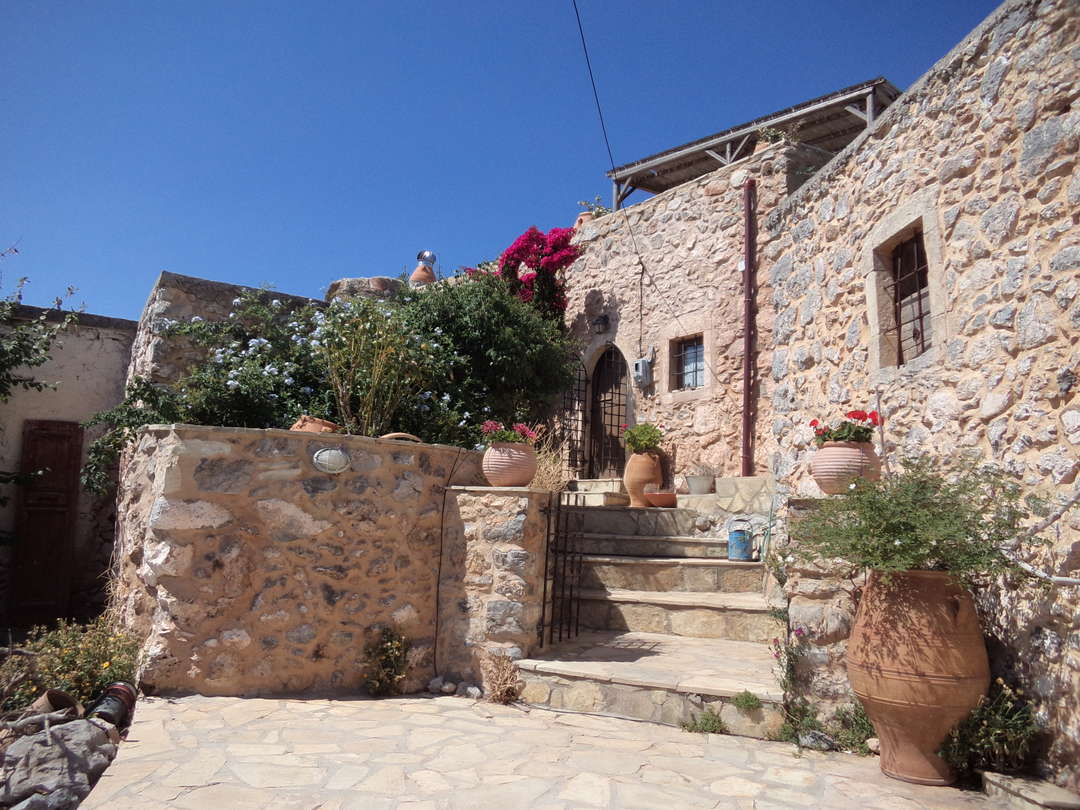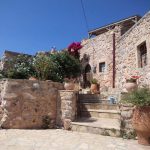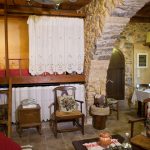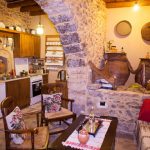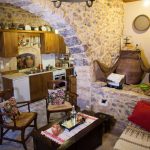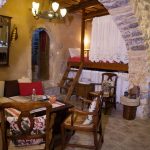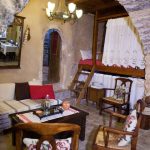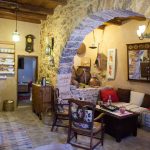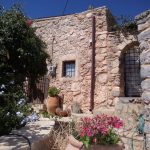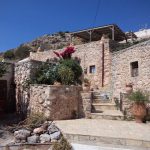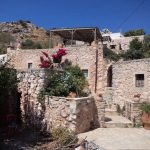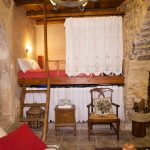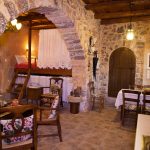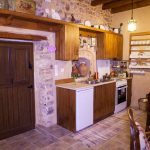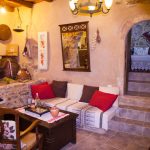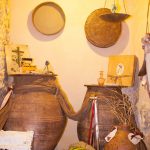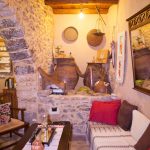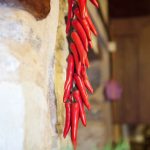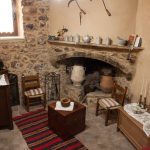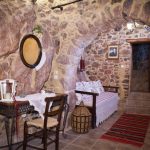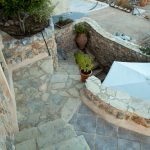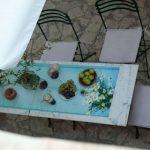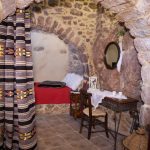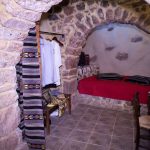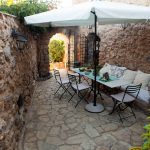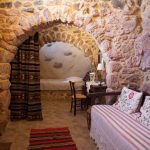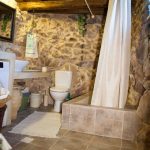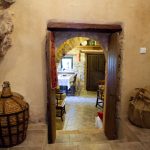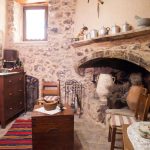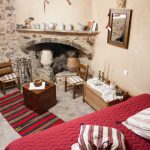The Rural Residence “MARIA”is an authentic, stone Cretan rural house with a rectangular layout of about 94 m2, a “kamarospito” (“arch house”) of two ground levels, following the slope of the mountain, with two private yards and a view of the hills, valleys, vineyards and gardens which surround the village. It is built entirely with local stone which the original owners used centuries ago and it can accommodate up to 6 people.
More information
The entrance to the house from the front yard leads to the first level which consists of a big open plan space divided by a stone arch into four autonomous areas, without disrupting the unity of the space. The areas are adjusted to the contemporary needs of accommodation preserving their original form and they include a kitchen, a dining area, a living room area consisting of two handmade armchairs and a built sofa and a stone “grape press” which in the old days had double use (for crashing grapes in September / bed for the children for the rest of the year) which was preserved in its original form containing old household utensils. Right across the “grape press” we rebuilt in its original form the traditional, elevated, wooden, double bed (“tavlado”) which can sleep two people.
On the first level, on the left of the open plan space is “the room with the fireplace”. A double stone bed and the authentic old fireplace of the house create a comfortable area to entertain your friends and family.
At the back of the open plan space a double-door with a stone arch leads to the second level of the house to a space which in the past was used as a storage area for food and drink (wine, olive oil, grain, etc). This level is about 1 m higher than the rest of the house. Here we preserved the interesting features of the original building like the two stone arches and the embedded large rocks on the walls. We have also embedded a double built bed and this is the main bedroom of the house “the room with the arches”. The old barn, right next to this space, was converted into a spacious bathroom with a shower, a built wash basin and a washing machine.
The stone walls of the old stable and the surrounding rocks have been preserved in their original form and have become the inner open-air yard which can be used as an open-air dining room or as a place to relax on the comfortable built sofa. A stone staircase leads to the private roof with its open-air sitting area (with a panoramic view of the hills, the valleys, the vineyards, the gardens and the whole village), to the communal open space “SELENA TERRACE” with a dining space, wood oven and BBQ and to the garden.
- The “MARIA” house – Sitanos Crete
- The “MARIA” house – Sitanos Crete
- The “MARIA” house – Sitanos Crete
- The “MARIA” house – Sitanos Crete
- The “MARIA” house – Sitanos Crete
- The “MARIA” house – Sitanos Crete
- The “MARIA” house – Sitanos Crete
- The “MARIA” house – Sitanos Crete
- The “MARIA” house – Sitanos Crete
- The “MARIA” house – Sitanos Crete
- The “MARIA” house – Sitanos Crete
- The “MARIA” house – Sitanos Crete
- The “MARIA” house – Sitanos Crete
- The “MARIA” house – Sitanos Crete
- The “MARIA” house – Sitanos Crete
- The “MARIA” house – Sitanos Crete
- The “MARIA” house – Sitanos Crete
- The “MARIA” house – Sitanos Crete
- The “MARIA” house – Sitanos Crete
- The “MARIA” house – Sitanos Crete
- The “MARIA” house – Sitanos Crete
- The “MARIA” house – Sitanos Crete
- The “MARIA” house – Sitanos Crete
- The “MARIA” house – Sitanos Crete
- The “MARIA” house – Sitanos Crete
- The “MARIA” house – Sitanos Crete
- The “MARIA” house – Sitanos Crete
- The “MARIA” house – Sitanos Crete
- The “MARIA” house – Sitanos Crete
- The “MARIA” house – Sitanos Crete
Amenities
There is a private front and a private inner yard with the necessary furniture, a fully equipped kitchen (ceramic cooker, fridge, coffee maker, toaster, etc), a dining area, a living room area, an elevated wooden double bed (“tavlado”), a fireplace, a desk, two separate bed rooms with double beds, a bathroom with a shower and a washing machine, an ironing board, Internet Wi-Fi, etc. The stone walls keep the house cool in the summer, so air conditioning is not necessary. We provide for free towels and sheets. About 70 meters from the house there is a private parking area where guests park their cars. The guests also have access to the communal open space “SELENA TERRACE” which has a dining space, wood oven and BBQ.
Guest access
A car is indispensable to access the property as well as visiting the numerous beaches in the island.
All the main roads leading to the village of Sitanos are asphalted. Visitors should avoid the dirt roads if they are not sure that they are in good condition and suitable for their car.
360
A FEW WORDS ABOUT THE HISTORY OF THE VILLAGE SITANOS
The village Sitanos is located 19 km south of Sitia and 53 km east of Ierapetra. It can be reached by the road connecting Sitia (and Ierapetra) with Chandras following the road to Voila – Katelionas – Sitanos – Karydi. There is also a secondary road connecting Sitia – Piskokefalo – Katsidoni – Sitanos – Karydi. It is a typical mountainous and semi-mountainous Cretan village where the Cretan rural architecture remained unchanged through the centuries.
Its name is connected to the name of ancient Itanos. It is believed that the etymology of its name has to do with the Itanians who, according to a legend, when they scattered after the earthquakes and the pirate raids came to the site where the village Sitanos (= of Itanos just as Sitia = of Itia) is today. Emmanouil Angelakis (Sitiaka A’, page 17) writes that the village existed during the Venetian occupation but it was destroyed by Turkish pirates in 1471 and was re-inhabited in the 16th or 17th century.
Its history is lost through the centuries of its existence. It starts at Later Minoan Times (Bronze Age 3000 to 1000 BC), since 150 m west of the village at the site “Katalymata” after surface research, remains of a (well-preserved) Minoan settlement was located (Davaras K. 1978 and Plato 1959). In the 1583 census data of the Venetian occupation, Sitanos is mentioned among the other villages of Sitia having 54 residents

